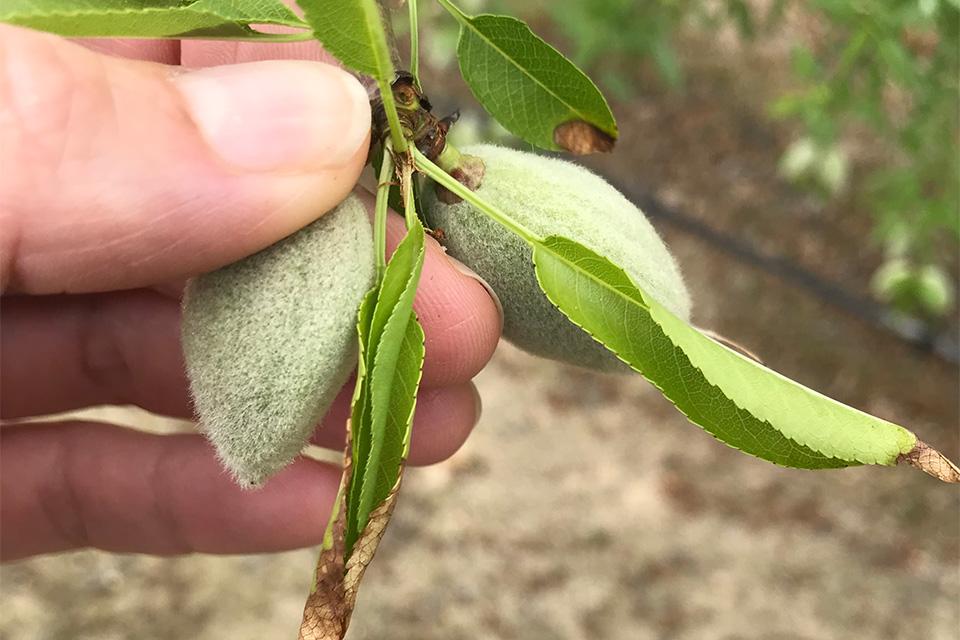Keys To Effective Potassium Management in Nut Crops

Necrotic leaf margins indicative of potassium (K) deficiency in pistachio. Management of potassium levels in nut crops is crucial to growing success.
Photo by Mae Culumber
Potassium (K) is among the most critical nutrients for California’s agricultural tree nut crops. As the most abundant cation in plant cells, K is as important as nitrogen (N) for the regulation of many plant metabolic functions.
Tree crop K deficiencies are associated with increased sensitivity to drought stress, susceptibility to frost damage, vulnerability to pests and disease, early leaf senescence, fruiting spur mortality, reduced flowering, and reduced crop yield and quality. An understanding of tree crop K requirements, availability in different soil environments, signs of deficiency, and the properties of different K fertilizers is critical to a K management program that effectively supports orchard growth, vigor, and productivity.
Almond/Pistachio Needs
Potassium requirements vary among tree nut crops. Almonds need roughly 80 pounds of elemental potassium (K) or 96 pounds of potassium oxide (K2O) for every 1,000 kernel pounds (Brown et al., 2012). Pistachios consume about 55 pounds of K2O per 1,000 pounds of nuts plus K for tree growth. Because of their strong alternate bearing characteristics, pistachio per acre K application rate fluctuates from year to year. “On” year pistachios require roughly two times more than what is needed in an “off” year (Zeng et al., 1997).
K Availability in Soil Environments
Soil lab diagnostics and an orchard’s geographic location can provide important clues as to the availability of K for tree uptake and nutrient management planning.
On the east side of San Joaquin Valley (SJV) and elsewhere, sandy clay loam, silt loam, and fine sand soils derived from Sierra Nevada granitic alluvium are high in silicate minerals (i.e., vermiculite and mica) that trap soluble K within their layered structures (Murashkina et al., 2007). Research has found K fixation in these areas is most prevalent below 8 inches (Pettygrove, 2014), which implies deep-rooted perennial tree crops are susceptible to deficiencies.
In K fixing soils, a portion of applied fertilizers will become fixed and unavailable for uptake, requiring heavier application rates. Lab procedures to estimate K-fixation potential are developed but generally not commercially available for analysis (Rees et al., 2013). Managers currently rely on other markers of K availability, mainly soluble and exchangeable K, to develop K fertility strategies.
Commonly included in a soil fertility analysis, soluble and exchangeable K values are important to consider when choosing the rate and timing of K fertilizer application. Soluble K represents the amount of K dissolved in the soil water that is immediately available for uptake.
Exchangeable K is the concentration occupying soil particle or organic matter surfaces that continuously replaces nutrients in the soil solution as they are taken up by tree roots. Generally, 100 ppm or higher exchangeable K suggests the soil has moderate to good ability to store K, and values below 100 ppm may be susceptible to leaching.

Here, necrotic leaf margins are indicating symptoms of potassium (K) deficiency on this almond tree.
Photo by Mae Culumber
Deficiency, Critical Tissue Levels
Slow growth, necrotic edges or spots on leaves, and small fruit are some of the visual symptoms of K deficiency. Leaf symptoms usually show up in early to mid-summer when the oldest leaves on the current season’s shoots begin to brown on the margins (Figure 1). Leaf necrosis can have other causes, including poor irrigation scheduling and salt accumulation, so it is important to conduct leaf and soil analyses to confirm.
Leaf tissue K nutrition can vary greatly across the orchard depending on soil conditions, and within a single tree depending on the proximity of leaves to developing clusters (Brown et al., 2012). At a minimum, leaves should be collected from 10 trees (10 leaves per tree) located at least 25 yards apart. Samples can be pooled to obtain a field average or analyzed individually to diagnose field level variability.
Mid-summer leaf tissue K should be at or above 1.4%. Tissue ranges between 1.5% and 1.7% generally have the highest yield outcomes, but K% values exceeding this are not likely to increase production and may be detrimental. Excessive K may interfere with the uptake of other important nutrients, including calcium (Ca) and magnesium (Mg).
K Application Rate, Timing
Fertilizer selection, rate, and application timing decisions should consider the known soil characteristics, crop uptake patterns, and the growing climate.
In almond about 45% to 61% of K accumulated in the fruit takes place in the first three months (86 days) after full bloom, suggesting K availability during spring is most critical. Pistachio uptake is more linear, so similar application rates can be made April through August to sustain soil K availability for developing clusters.
Non-fixing clay or loam soils with a high exchange capacity may only need a large dose in the dormant period to ensure adequate K is there the following spring. In soils prone to K fixation, a fall banded application, in-season fertigation, and foliar applications may be needed to overcome fixation and deliver K directly to the rootzone.
Sandy soils with lower exchange capacities are susceptible to leaching and need multiple smaller applications throughout the year. Some growers are finding success using compost and other organic materials to supplement crops K needs. Recent research has shown tree crop residues not only provide a source of soluble K, but also increase soil water content to facilitate K uptake.









